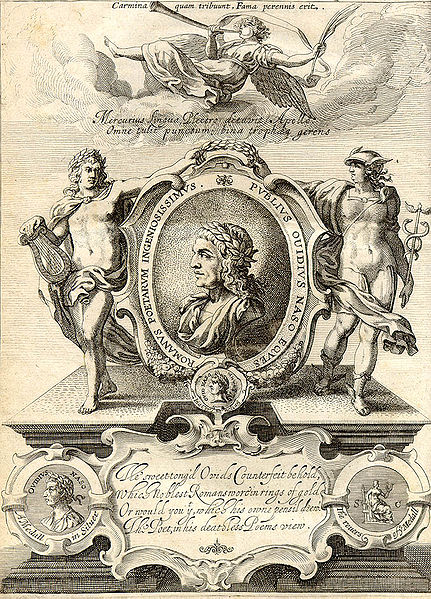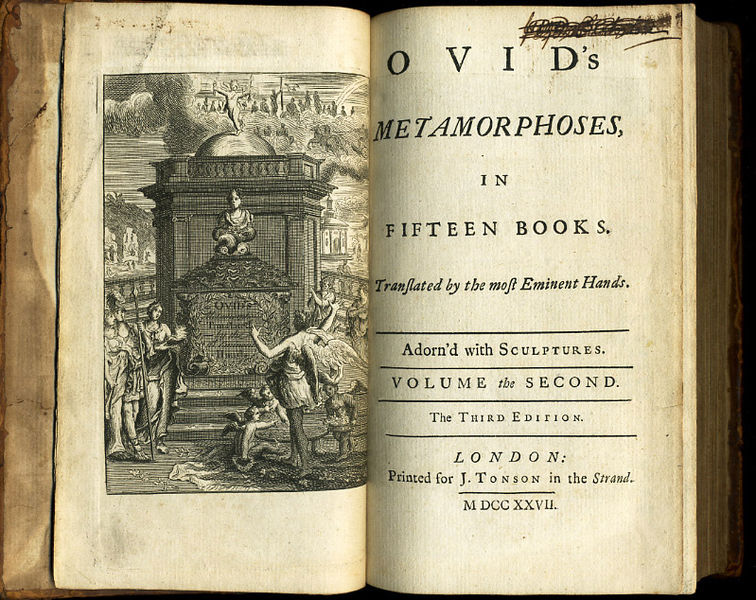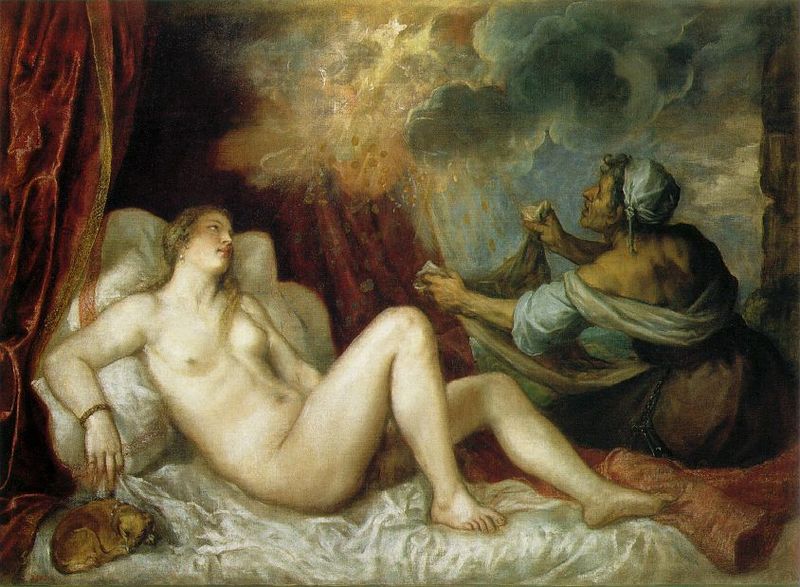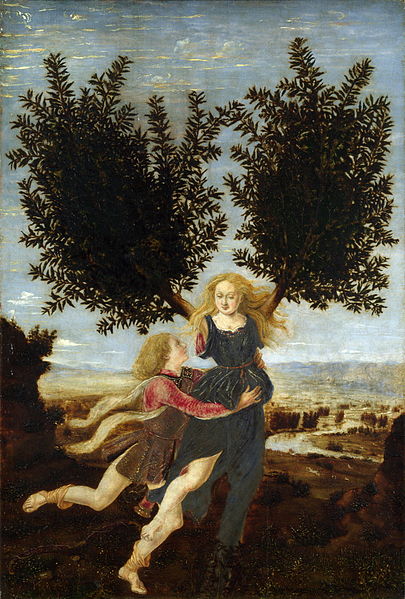<Back to Index>
- Publius Ovidius Naso Metamorphoses, 8
PAGE SPONSOR


Metamorphoses (from Greek μετά meta and μορφή morphē, meaning "changes of shape"), is a Latin narrative poem in fifteen books by the Roman poet Ovid describing the history of the world from its creation to the deification of Julius Caesar within a loose mythico - historical framework. Completed in AD 8, it is recognized as a masterpiece of Golden Age Latin literature. The most read of all classical works during the Middle Ages, the Metamorphoses continues to exert a profound influence on Western culture. It also remains the favourite work of reference for Greek myth upon which Ovid based these tales, albeit often with stylistic adaptations.
Content
Ovid works his way through his subject matter, often in an apparently arbitrary fashion, by jumping from one transformation tale to another, sometimes retelling what had come to be seen as central events in the world of Greek mythology and sometimes straying in odd directions. The poem is often called a mock - epic. It is written in dactylic hexameter, the form of the great heroic and nationalistic epic poems, both those of the ancient tradition (the Iliad and the Odyssey) and of Ovid's own day (the Aeneid by Virgil). It begins with the ritual "invocation of the muse", and makes use of traditional epithets and circumlocutions. But instead of following and extolling the deeds of a human hero, it leaps from story to story with little connection.The recurring theme, as with nearly all of Ovid's work, is love — be it personal love or love personified in the figure of Amor (Cupid). Indeed, the other Roman gods are repeatedly perplexed, humiliated, and made ridiculous by Amor, an otherwise relatively minor god of the pantheon, who is the closest thing this putative mock - epic has to a hero. Apollo comes in for particular ridicule as Ovid shows how irrational love can confound the god out of reason. The work as a whole inverts the accepted order, elevating humans and human passions while making the gods and their desires and conquests objects of low humor.
The Metamorphoses can be said to be unique in that it is the only Latin mock - epic to have an epilogue. This epilogue (Book 15, lines 871 - 879) is Ovid's way of telling his readers that everything is in flux, but that the exception to this is the Metamorphoses, "Now stands my task accomplished, such a work as not the wrath of Jove, nor fire nor sword nor the devouring ages can destroy". The idea that this implies is that the authors gain "immortality" through the survival of their works.
Main episodes
- Book I: Cosmogony, Ages of Man, Gigantes, Daphne, Io;
- Book II: Phaëton, Callisto, Jupiter and Europa;
- Book III: Cadmus, Actaeon, Echo and Pentheus;
- Book IV: Pyramus and Thisbe, Hermaphroditus and Salmacis, Perseus and Andromeda.
- Book V: Phineas, the Rape of Proserpina;
- Book VI: Arachne, Niobe, Philomela and Procne;
- Book VII: Medea, Cephalus and Procris;
- Book VIII: Nisos and Scylla, Daedalus and Icarus, Baucis and Philemon;
- Book IX: Heracles, Byblis;
- Book X: Eurydice, Hyacinth, Pygmalion, Myrrha, Adonis, Atalanta, Cyparissus;
- Book XI: Orpheus, Midas, Alcyone and Ceyx;
- Book XII: Iphigeneia, Centaurs, Achilles; Aesacus
- Book XIII: the Sack of Troy, Aeneas;
- Book XIV: Scylla, Aeneas, Romulus;
- Book XV: Pythagoras, Hippolytus, Aesculapius, Caesar.
Inspirations and adaptations
The story of Coronis and Phoebus Apollo was adapted by Geoffrey Chaucer in the Canterbury Tales, where it forms the basis for the Manciple's tale.
Metamorphoses was a considerable influence on English playwright William Shakespeare. Shakespeare's Romeo and Juliet is influenced by the story of Pyramus and Thisbe (Metamorphoses Book 4), and, in A Midsummer Night's Dream, a band of amateur actors performs a play about Pyramus and Thisbe. In Titus Andronicus, the story of Lavinia's rape is drawn from Tereus' rape of Philomela, and the text of Metamorphoses is used within the play to enable Titus to interpret his daughter's story. Yet, most tellingly, Shakespeare adapts, with minor changes, a passage from Book 7 of the Golding translation into an important speech in Act V of The Tempest.
- In 1613, Spanish poet Luis de Góngora wrote an illustrious poem titled La Fábula de Polifemo y Galatea that retells the story of Polyphemus, Galatea and Acis found in Book XIII of the Metamorphoses.
- In 1625, sculptor Gian Lorenzo Bernini finished his piece entitled Apollo and Daphne, taken from the episode in Book 1 in which Apollo, pierced by a love - inducing arrow from Cupid, pursues the fleeing nymph Daphne. This episode furthermore has been treated repeatedly in opera, notably by Jacopo Peri (Dafne) in 1597 and Richard Strauss (Daphne, with a libretto that deviates significantly from Ovid's account) in 1938.
- In 1783, Austrian composer Karl Ditters von Dittersdorf wrote twelve symphonies on selected stories of the Metamorphoses; only six survive, corresponding to stories from the first six books.
- In 1951, British composer Benjamin Britten wrote a piece for solo oboe incorporating six of Ovid's mythical characters.
- In 1988, author Christoph Ransmayr reworked a great number of characters from the Metamorphoses in his The Last World.
- In 1997, the British poet laureate Ted Hughes adapted twenty-four stories from the Metamorphoses into his volume of poetry Tales from Ovid. This was later adapted for the stage in Stratford - upon - Avon in 1999, the year after Hughes's death..
- In 2000, author Phillip Terry edited a collection of modern adaptations of some of Ovid's myths as Ovid Metamorphosed. Contributors included Margaret Atwood.
- In 2002, author Mary Zimmerman adapted some of Ovid's myths into a play by the same title, and the open - air - theatre group London Bubble also adapted it in 2006.
- Naomi Iizuka's Polaroid Stories also bases its format on Metamorphoses, adapting Ovid's poem to modern times with drug - addicted, teenage versions of many of the characters from the original play.
- Acis and Galatea, a masque by Händel, is based on the eponymous characters out of the Metamorphoses, as is Lully's opera Acis et Galatée.
- Jazz artist Patricia Barber's 2006 album, Mythologies, is a set of songs based on Ovid's Metamorphoses.
- Jazz saxophonist Branford Marsalis's 2009 album Metamorphosen is based on Ovid's epic Metamorphoses.
- In 2009, British Author Adrian Mitchell made a collection entitled "Shapeshifters: Tales from Ovid's Metamorphoses". This is one of Mitchell's last books, as he died in 2008 and it was published afterwards.
- In 2010, the Yvonne Arnaud Theatre presented a new adaptation of Metamorphoses at the Edinburgh Festival Fringe.
Manuscript tradition
Ovid's Metamorphoses was an immediate success (although Quintilian considered Ovid's tragedy Medea his best work), its popularity threatening that of Virgil's Aeneid. It was considered such a definitive work on mythology that Seneca joked in his Apocolocyntosis that the deification of Claudius should be added to the Metamorphoses. But the poem's immense popularity in antiquity and the Middle Ages belies the struggle for survival it faced in late antiquity. "A dangerously pagan work," the Metamorphoses was preserved through the Roman period of Christianization, but was criticized by the voices of Augustine and Jerome, who believed the only metamorphosis really was the transubstantiation. Though the Metamorphoses did not suffer the ignominious fate of the Medea, no ancient scholia on the poem survive (although they did exist in antiquity), and the earliest manuscript is very late, dating from the 11th century.
The poem retained its popularity throughout Late Antiquity and the Middle Ages, and is represented by an extremely high number of surviving manuscripts (more than 400); the earliest of these are three fragmentary copies containing portions of Books 1-3, dating to the ninth century.
Collaborative editorial effort has been investigating the various manuscripts of Metamorphoses, some forty - five complete texts or substantial fragments, all deriving from a Gallic archetype. The
result of several centuries of critical reading is that the poet's
meaning is firmly established on the basis of the manuscript tradition
or restored by conjecture where the tradition is deficient. There are
two modern critical editions: William S. Anderson's, first published in
1977 in the Teubner series, and R.J. Tarrant's, published in 2004 by
the Oxford Clarendon Press.

